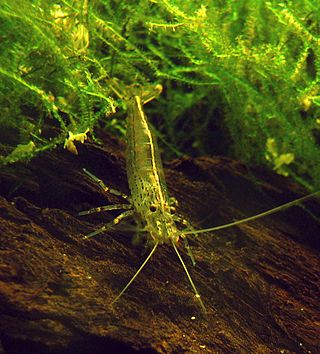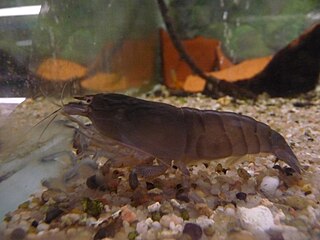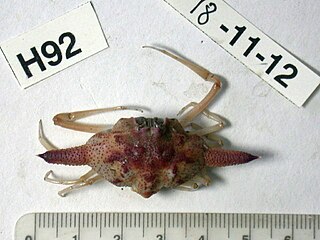
Xanthidae is a family of crabs known as gorilla crabs, mud crabs, pebble crabs or rubble crabs. Xanthid crabs are often brightly coloured and are highly venomous, containing toxins which are not destroyed by cooking and for which no antidote is known. The toxins are similar to the tetrodotoxin and saxitoxin produced by puffer fish, and may be produced by bacteria in the genus Vibrio living in symbiosis with the crabs, mostly V. alginolyticus and V. parahaemolyticus.

Atyidae is a family of shrimp, present in all tropical and most temperate waters of the world. Adults of this family are almost always confined to fresh water. This is the only family in the superfamily Atyoidea.

The velvet crab, or alternately velvet swimming crab, devil crab, “fighter crab”, or lady crab,Necora puber, is a species of crab from the North-East Atlantic and the Mediterranean. It is the largest of the swimming crab family (Portunidae) found in British coastal waters. It has a carapace width of up to 100 millimetres (3.9 in), and is the only species in the genus Necora. Its body is coated with short hairs, giving the animal a velvety texture, hence the common name. It is one of the major crab species for United Kingdom fisheries, in spite of its relatively small size.

Atya is a genus of freshwater shrimp of the family Atyidae, ranging through the Antilles and along the Atlantic and Pacific slopes of Central and South America and in western Africa. It contains the following species:

Scyllarides latus, the Mediterranean slipper lobster, is a species of slipper lobster found in the Mediterranean Sea and in the eastern Atlantic Ocean. It is edible and highly regarded as food, but is now rare over much of its range due to overfishing. Adults may grow to 1 foot (30 cm) long, are camouflaged, and have no claws. They are nocturnal, emerging from caves and other shelters during the night to feed on molluscs. As well as being eaten by humans, S. latus is also preyed upon by a variety of bony fish. Its closest relative is S. herklotsii, which occurs off the Atlantic coast of West Africa; other species of Scyllarides occur in the western Atlantic Ocean and the Indo-Pacific. The larvae and young animals are largely unknown.

Xantho poressa, the jaguar round crab, is a species of crab from the eastern Atlantic Ocean. It is one of four species in the genus Xantho.

Macropodia is a genus of crabs, belonging to the family Inachidae. It contains the following species:

Xantho is a genus of crabs in the family Xanthidae, containing five extant species, all restricted to the north-east Atlantic Ocean and Mediterranean Sea, although Xantho granulicarpis is not universally recognised as a separate species from Xantho hydrophilus:

Inachus phalangium, Leach's spider crab, is a species of crabs from the north-eastern Atlantic Ocean and Mediterranean Sea. It is up to 20.5 mm (0.81 in) wide, and is very similar to other species in the genus Inachus.

Inachus is a genus of crab, containing the following species:

Pirimela is a genus of crab containing a single species, Pirimela denticulata.
Calcinus tubularis is a species of hermit crab. It is found in the Mediterranean Sea and around islands in the Atlantic Ocean, where it lives below the intertidal zone. Its carapace, eyestalks and claws are marked with numerous red spots. C. tubularis and its sister species, C. verrilli, are the only hermit crabs known to show sexual dimorphism in shell choice, with males using normal marine gastropod shells, while females use shells of gastropods in the family Vermetidae, which are attached to rocks or other hard substrates.

Polybius henslowii is a species of crab, the only species in the genus Polybius. It is a capable swimmer and feeds in open water in the north-east Atlantic Ocean and western Mediterranean Sea.

Achaeus is a genus of crabs comprising the following species:

Geryon trispinosus is a species of crab that lives in deep water in the north-eastern Atlantic Ocean.
Liocarcinus zariquieyi is a species of crab that lives in the Mediterranean Sea. It is very similar to Liocarcinus pusillus, and was for a long time confused with that species.

Albunea carabus is a rare species of "sand crab" or "mole crab" in the genus Albunea. It lives in shallow, turbulent waters in sandy areas of the tropical eastern Atlantic Ocean and the Mediterranean Sea.
Automate branchialis is a species of pistol shrimp from the family Alpheidae which was thought to be a Lessepsian migrant, i.e. a species which had colonised the Mediterranean from the Red Sea via the Suez Canal. This was because before its description in 1958 all the species of the genus Automate were found in the Indo-Pacific region. A. branchialis has not been recorded in the Indo-Pacific region and has been found to be widespread in the Mediterranean so it is now considered to be a Mediterranean endemic.

Ixa monodi, the Red Sea pebble crab is a species of pebble crab from the family Leucosiidae which prefers to burrow in sandy, shallow coastal waters. It was first described from the eastern Mediterranean where it is an invasive species having colonised the coasts of the Levantine Sea from the Red Sea by Lessepsian migration from the Red Sea via the Suez Canal.

Lekanesphaera is a genus of Isopod in the family Sphaeromatidae. It was split off from Sphaeroma by Karl Wilhelm Verhoeff, 1943.: The type species is L. monodi. Other well-studied species are L. glabella (Madera), L. rugicauda (Baltic), and L. hookeri. Because they inhabit intertidal zones such as estuaries, their adaptation to diurnal variations in factors such as salinity are often studied.
















